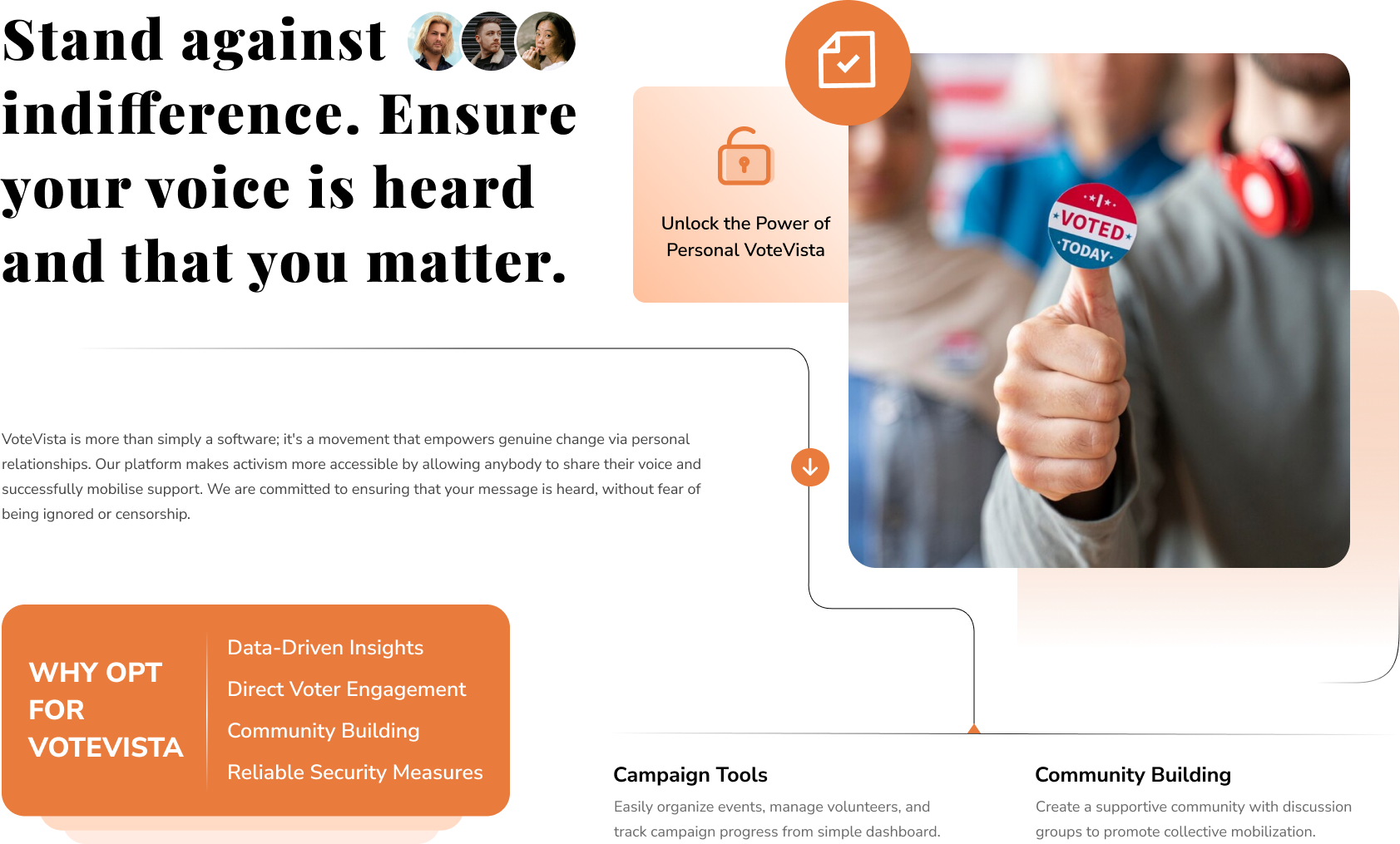
About the Customer
A US-based IT firm, our client, aimed to develop a platform designed for extensive vote vista. They observed that numerous political parties, nonprofits, and other organizations struggled to effectively connect with their audience. Their vote vista efforts were scattered and lacked a unified strategy, resulting in lost engagement and mobilization opportunities.
Identifying the need for a more efficient and optimized method, they set out to overhaul their vote vista initiatives. The objective was straightforward: to devise a solid, data-driven vote vista strategy that would appeal to their varied audience and spur action.
In this venture, the client sought our expertise. Our team collaborated closely with them to comprehend their goals, hurdles, and the distinct dynamics of vote vista for various organizations. We carried out thorough research, encompassing surveys and interviews, to understand the preferences and behaviors of different organizations and their audience.
Our research uncovered several crucial areas needing enhancement. For example, we discovered that a considerable segment of various organizations’ audience was not effectively engaged due to the absence of personalized communication. We also found that the party was not fully utilizing digital platforms for vote vista, leading to lost chances to engage with younger, tech-savvy audiences.
Based on these insights, we devised an all-encompassing vote vista strategy for different organizations. This strategy involved the initiation of targeted communication campaigns, the integration of cutting-edge data analytics for engagement tracking, and the deployment of digital platforms to widen their reach.
This case study stands as a testament to the effectiveness of a well-conceived and executed vote vista strategy. By understanding their audience and employing the appropriate tools and channels, political parties, nonprofits, and other organizations can significantly boost their vote vista efforts and foster meaningful engagement.

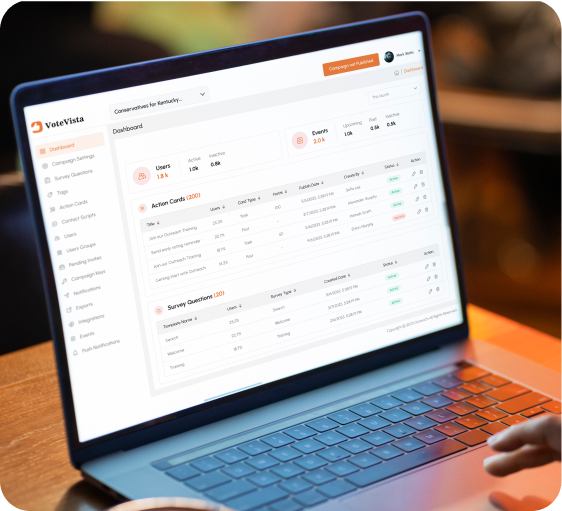
Project Overview
The Vote Vista App, a project built on the Java Spring Boot platform, utilizes a microservices architecture. It comprises several components, each catering to a specific role – an Admin web app, a Campaign Owner web app, a User web app, and a User mobile app compatible with both iOS and Android.
The Campaign Owner has the ability to kick-start campaigns, define subscription features, and oversee a variety of campaign elements. These include survey questions, action cards, contact scripts, user management, chat group administration, and event planning. These features are interconnected, offering a range of customizable actions for the audience to engage with.
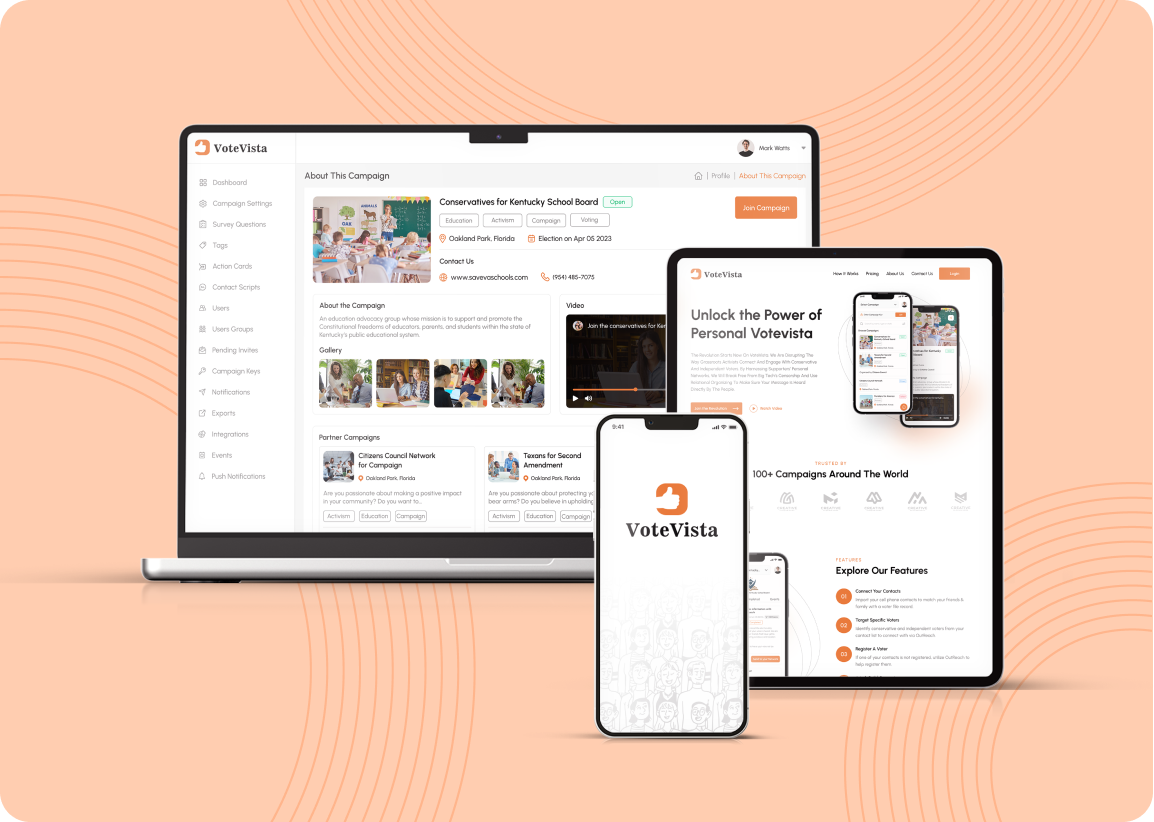
Purpose
The Vote Vista App is designed with the primary purpose of revolutionizing the way vote vista campaigns are managed and executed. It serves as a comprehensive platform that empowers campaign owners with a suite of tools and features to effectively engage with their audience.
At the heart of the app is the campaign management feature. This allows campaign owners to kick-start their campaigns by setting up the campaign, objectives, target audience, and other key parameters. They can also manage various aspects of the campaign such as survey questions, action cards, and contact scripts, chat groups, events tailoring their campaigns to their specific needs and objectives.
Another key feature of the app is its ability to collect and analyze data from the campaigns. This data-driven approach helps campaign owners understand their audience better, measure the effectiveness of their campaigns, and make informed decisions to optimize their vote vista efforts.
Finally, the app includes a feature for creating and integrating survey forms with respective action cards. This allows the audience to provide immediate feedback or answer questions relevant to the campaign, providing valuable insights for the campaign.
Business Challenge
Campaign owners face the challenge of efficiently organizing and managing campaigns, ensuring high user engagement, and obtaining meaningful insights into campaign performance. The need for a centralized platform that supports various campaign modules prompted the development of the Vote Vista App.
The challenges were as follows:
- Fragmented Vote Vista
The party’s Vote Vista efforts were scattered across different platforms and lacked a unified strategy, leading to inconsistent messaging and missed opportunities for engagement.
- Inefficient Communication
There was a lack of personalized communication, which made it difficult to effectively engage with different segments of their audience.
- Underutilized Digital Platforms
The party was not fully leveraging digital platforms for Vote Vista, resulting in missed opportunities to connect with younger, tech-savvy voters.
- Lack of Data-Driven Strategy
The party’s Vote Vista strategy was not informed by data, leading to inefficiencies and suboptimal results.
The goal of the project was to address these challenges by developing a comprehensive, data-driven Vote Vista strategy that would resonate with their diverse audience and inspire action.
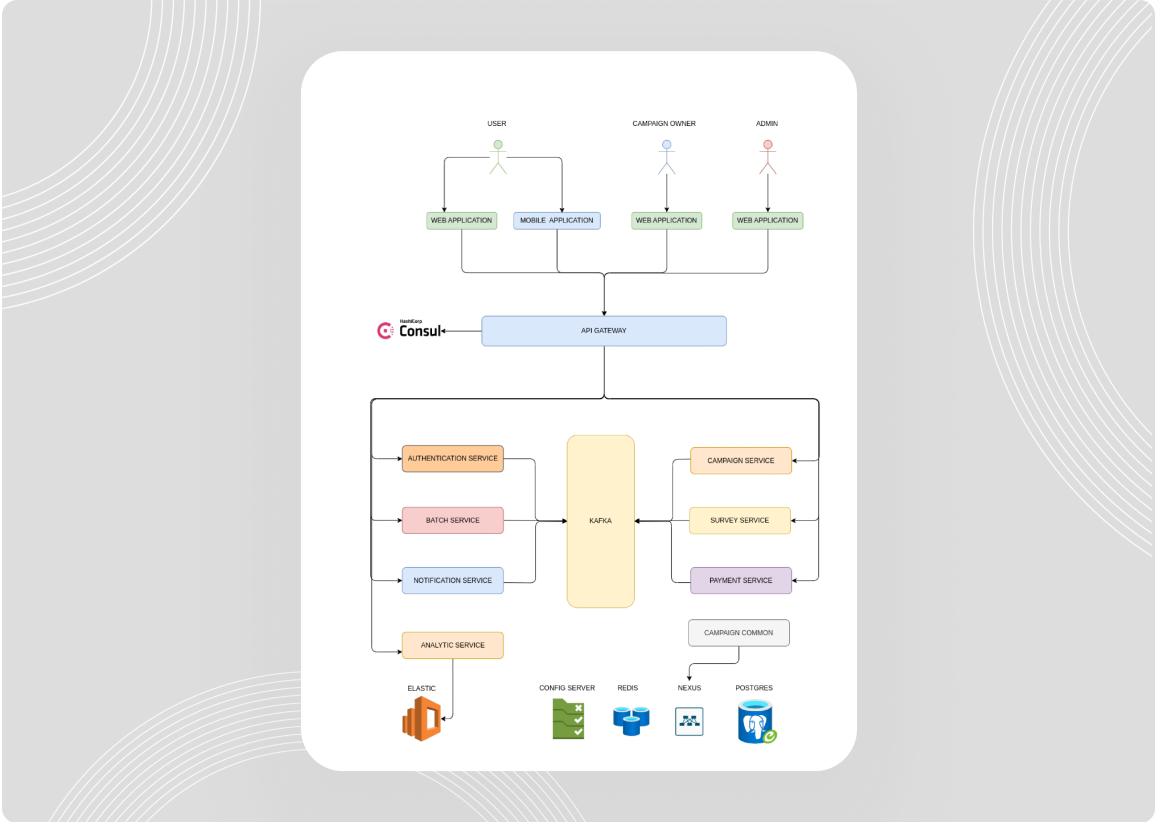
Our Solution
The Vote Vista App addresses these challenges by providing a subscription-based model with features like unlimited user participation, leaderboard management, linked campaigns, customizable survey questions and action cards. The microservices architecture, powered by Java Spring Boot, ensures scalability, flexibility, and seamless communication through Kafka. The integration of Redis for caching and PostgreSQL for robust data storage enhances performance and reliability.
Here are some of its key functionalities:
- Campaign Management
Campaign owners can initiate campaigns and set subscription features. They can also manage various aspects of the campaign such as survey questions, action cards, and contact scripts.
- User Management
The app allows for efficient management of users and chat groups, facilitating better communication and engagement.
- Event Management
Campaign owners can plan and manage events, enhancing the reach and impact of their campaigns.
- Customizable Action Cards
The Vote Vista App provides the audience with a range of customizable action cards. These action cards serve as interactive elements that the audience can engage with during a campaign. They can be tailored to suit the specific needs and objectives of each campaign, allowing for a high degree of flexibility and personalization.
For instance, an action card could prompt the audience to:
- Fill out network surveys or personal surveys, providing valuable feedback and data to the campaign.
- Redirect to external links, expanding the scope of information and resources available to the audience.
- Text their network or email their contacts, facilitating peer-to-peer sharing and expanding the reach of the campaign.
- Redirect the user to internal modules to complete tasks, seamlessly integrating various campaign activities.
By providing a more interactive and engaging way to participate in the campaign, these customizable action cards can significantly enhance user engagement and campaign effectiveness. They offer a dynamic way to connect with the audience and inspire them to take action.
- Integrated Survey Forms
The Vote Vista App includes a feature for creating and integrating survey forms with respective action cards. During the action card creation process, campaign owners have the option to link a survey form to the action card. This allows the audience to provide immediate feedback or answer questions relevant to the campaign. The responses collected from these surveys can provide valuable insights for the campaign, helping to inform future strategies and actions. This integration of survey forms and action cards creates a seamless experience for the audience and enhances the interactive nature of the campaign.
- Role-Based Access
The app features role-based access control (RBAC), with different interfaces for admins, campaign owners, and users. This ensures that each user has access to the features and information relevant to their role.
In essence, the Vote Vista App serves as a one-stop solution for managing and enhancing Vote Vista efforts, making it easier for political parties, nonprofits, and other organizations to connect with their audience and inspire action.
Key Challenges
Indeed, designing a scalable and responsive platform capable of handling multiple concurrent campaigns was one of the key challenges we faced. The complexity of managing various campaigns simultaneously required a robust and flexible architecture.
We addressed this challenge by implementing a Microservices Architecture, which allowed us to break down the application into smaller, independent modules. Each module could then be developed, deployed, and scaled independently, providing the flexibility we needed to handle multiple campaigns concurrently.
To facilitate communication between these microservices, we utilized Kafka, a distributed streaming platform. Kafka enabled real-time data exchange between the microservices, ensuring they could work together seamlessly despite being separate entities.
Additionally, we used Consul for service registry and discovery. Consul provided a centralized service registry, which made it easier to manage and coordinate the various microservices. It also enabled service discovery, allowing the microservices to locate and communicate with each other efficiently.
Through the combination of Microservices Architecture, Kafka, and Consul, we were able to create a scalable and responsive platform that successfully met the challenge of managing multiple concurrent campaigns. This approach ensured that each module functioned independently while maintaining seamless communication, leading to an efficient and effective Vote Vista strategy.

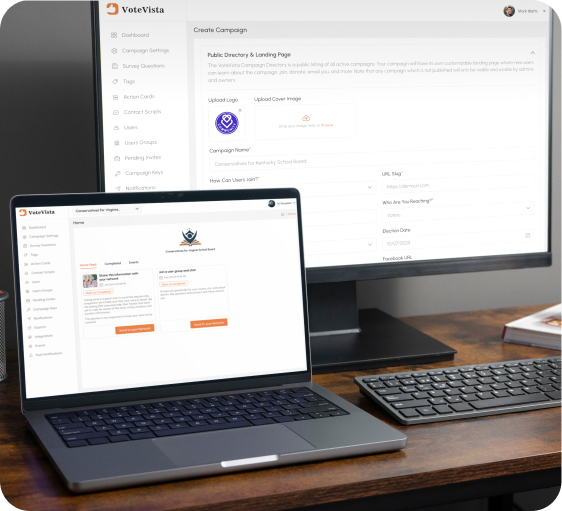
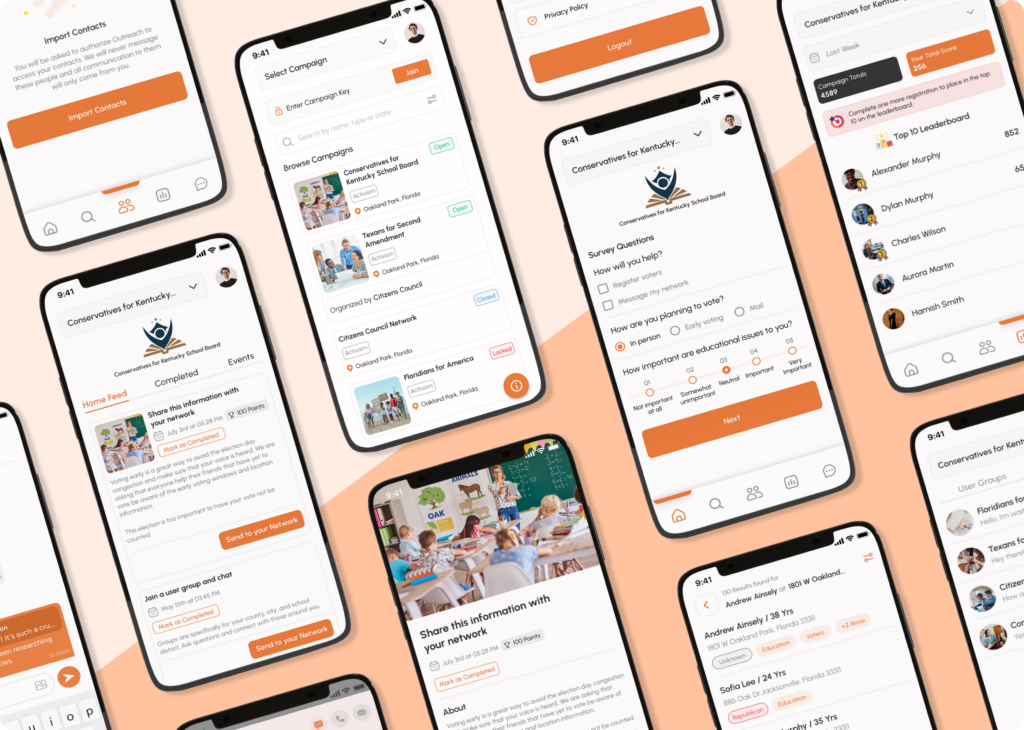
Project Name
VoteVista
Category
App & Web Development
Technology Stack
- Backend: Java Spring Boot
- Service Registry: Consul
- Database: PostgreSQL
- Caching: Redis
- Artifact Repository: Nexus
- Frontend: React (managed separately)
- Microservices Communication: Apache Kafka
Industry
Politics










